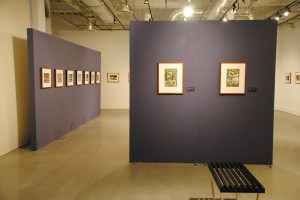Two artists who lived more than 100 years apart were brought together this past Wednesday night by a common theme — exploration into, and portrayal of, the human condition.
The College’s Gallery Director, Emily Croll, welcomed art enthusiasts and casual observers to bask in the gloriously terrifying and awe-inspiring work of prominent Spanish artists Federico Castellon and Francisco de Goya during this semester’s first art exhibit opening.
The main exhibit, cleverly titled Fear and Folly, is split into two sections displaying the historically separated, but thematically congruent, works of Goya and Castellon side-by-side.
On one side of the exhibit is Goya’s gruesome display of pieces called “Los Disparates,” or “The Follies,” that play on the terrible events of the Napoleonic invasion of Spain.
The court painter to the Spanish royal family at the time, Goya parallels the invasion’s circumstances in myriad incarnations of gloom.

For example, the intriguing yet shocking “Fearful Folly,” depicts a grim reaper-esque figure towering over a gaggle of fearful soldiers, a strong contrast between dark and light, which meant to showcase the concept of death.
On the other side is Castellon’s work, a literary comment on a short story called “The Masque of Red Death,” written by the notoriously death-obsessed Edgar Allen Poe.
According to the exhibit’s introduction wall, Castellon chose “The Masque of the Red Death” when he was commissioned to depict a story by the famous poet. What is quite illuminating about this collection is that, without even reading a word of Poe’s story, one could get a pretty accurate picture of the horror that takes place.
“It really catches your attention,” said sophomore gallery assistant and art education major Erin Chamberlin in reference to Castellon’s “The Dagger Dropped Gleaming upon the Sable Carpet.” The painting portrays an event toward the end of The Masque in which the Red Death — a deadly disease that parallels the symptoms of tuberculosis — is disguised as an anthropomorphic hooded figure much like Goya’s “Fearful Folly.”
The Prince of the story goes on to stab the Red Death but suddenly drops dead as a result of instant infection. Above and beyond death, Croll made it clear that bringing such a shocking exhibit to the campus is an exercise in edification.
“I want to bring exhibits that relate to different disciplines, exhibits that will relate to art and art education, but also to other departments within the school,” she said.
Fear and Folly’s art is aimed at reeling in a broader audience and will remain open until March 7, according to Croll.






